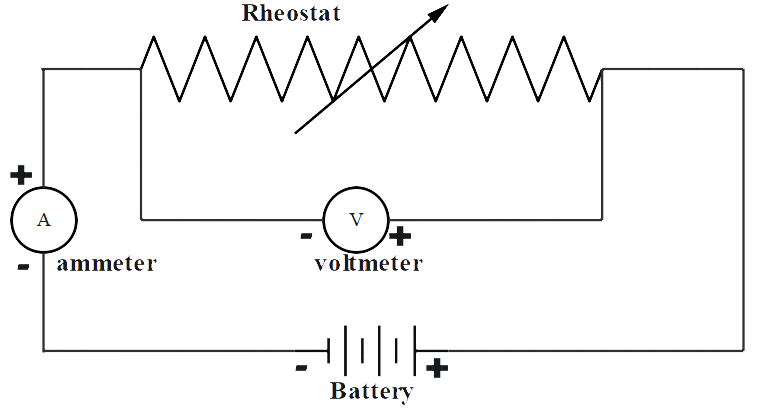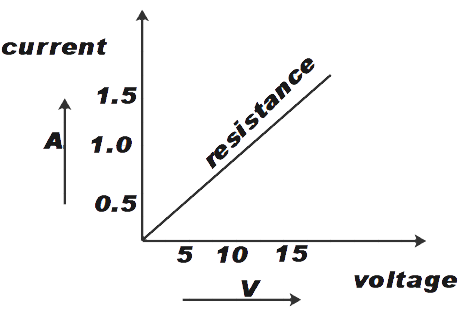
Draw a labelled diagram of the experiment explaining Ohm’s Law.
Answer
567k+ views
Hint: We know that Ohm's law states the relation between current flowing through a conductor and the potential difference applied across its ends. We will now verify this law by using a variable resistor or rheostat to vary the resistance for various reading voltmeters to read the potential difference across the rheostat and ammeter to measure current flowing in the circuit.
Complete step by step answer:
To verify Ohm’s Law, we need to arrange the components of the circuit as shown in the given figure.

Connect the voltmeter across the terminals of the rheostat. Connect the ammeter and the battery in series to the rheostat. When all the circuit is complete insert the key and slide the rheostat to check the deflections in ammeter and voltmeter. Now insert the key again and slide the rheostat to vary the resistance in the circuit. Now, measure the current flowing in the circuit and the potential difference across the resistor. Again repeat the same procedure by varying the rheostat further and measure the current and potential difference. Repeat the procedure minimum five times and note down the reading of current and potential difference. Note the readings of current under column I and potential difference under column V. Now calculate the value of V over I for each reading taken. Now, write these calculated readings under column R. You will notice that the readings in column R are not much deviated. The readings appear to be constant. Plot a graph of the relation.
This experiment therefore, states that current flowing through a conductor is directly proportional to the voltage across two points of the conductor.
Therefore,
\[I\propto V\]
Now, after introducing the constant of proportionality we get our equation for Ohm’s law
\[I=\dfrac{V}{R}\]
Or, \[V=IR\]
Where,
V is in volts, V
I is in Amperes, A
And R is ohms, \[\Omega \]
Therefore, we can say that Ohm’s Law is verified.
Additional Information:
If the graph of Voltage vs Current is drawn the slope of the graph will give us the resistance as shown in the figure.

Note:
Students must note that only if the displacement of a body has some component parallel to or anti parallel to the direction of the force applied on it, then only some non zero quantity of work is done by the force. If the force applied and the displacement of the body are in perpendicular directions, this would mean that the displacement has no component along or opposite to the direction of the force and in turn this would mean that the work done by the force is zero, even though the force on the body and its displacement are non zero.
Complete step by step answer:
To verify Ohm’s Law, we need to arrange the components of the circuit as shown in the given figure.

Connect the voltmeter across the terminals of the rheostat. Connect the ammeter and the battery in series to the rheostat. When all the circuit is complete insert the key and slide the rheostat to check the deflections in ammeter and voltmeter. Now insert the key again and slide the rheostat to vary the resistance in the circuit. Now, measure the current flowing in the circuit and the potential difference across the resistor. Again repeat the same procedure by varying the rheostat further and measure the current and potential difference. Repeat the procedure minimum five times and note down the reading of current and potential difference. Note the readings of current under column I and potential difference under column V. Now calculate the value of V over I for each reading taken. Now, write these calculated readings under column R. You will notice that the readings in column R are not much deviated. The readings appear to be constant. Plot a graph of the relation.
This experiment therefore, states that current flowing through a conductor is directly proportional to the voltage across two points of the conductor.
Therefore,
\[I\propto V\]
Now, after introducing the constant of proportionality we get our equation for Ohm’s law
\[I=\dfrac{V}{R}\]
Or, \[V=IR\]
Where,
V is in volts, V
I is in Amperes, A
And R is ohms, \[\Omega \]
Therefore, we can say that Ohm’s Law is verified.
Additional Information:
If the graph of Voltage vs Current is drawn the slope of the graph will give us the resistance as shown in the figure.

Note:
Students must note that only if the displacement of a body has some component parallel to or anti parallel to the direction of the force applied on it, then only some non zero quantity of work is done by the force. If the force applied and the displacement of the body are in perpendicular directions, this would mean that the displacement has no component along or opposite to the direction of the force and in turn this would mean that the work done by the force is zero, even though the force on the body and its displacement are non zero.
Recently Updated Pages
A man running at a speed 5 ms is viewed in the side class 12 physics CBSE

The number of solutions in x in 02pi for which sqrt class 12 maths CBSE

State and explain Hardy Weinbergs Principle class 12 biology CBSE

Write any two methods of preparation of phenol Give class 12 chemistry CBSE

Which of the following statements is wrong a Amnion class 12 biology CBSE

Differentiate between action potential and resting class 12 biology CBSE

Trending doubts
What are the major means of transport Explain each class 12 social science CBSE

Which are the Top 10 Largest Countries of the World?

Draw a labelled sketch of the human eye class 12 physics CBSE

Explain sex determination in humans with line diag class 12 biology CBSE

Explain sex determination in humans with the help of class 12 biology CBSE

Differentiate between homogeneous and heterogeneous class 12 chemistry CBSE




